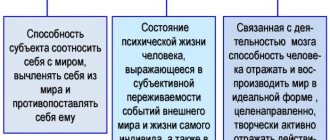Functions of consciousness
Acting as the most important component of personality, consciousness successfully performs a number of functions, including the following:
- cognitive – thanks to consciousness, a person forms a system of knowledge;
- goal-setting - the individual is aware of his needs, carries out goal setting, planning strategies to achieve his goals;
- value-oriented – a person analyzes, evaluates phenomena and processes of reality, and formulates his attitude towards them;
- managerial - the individual exercises control over his own behavior, the implementation of his own behavioral patterns in accordance with the set goals, formulated strategies for achieving them;
- communicative – consciousness exists and is transmitted in a symbolic form, and is closely related to the communicative activity of the individual;
- reflexive – thanks to consciousness, a person exercises self-control, self-awareness, self-regulation, which provides opportunities for personal development.
Are you an expert in this subject area? We invite you to become the author of the Directory Working Conditions
Consciousness as a mental process: its structure, functions and characteristics
- home
- State exam in the specialty Psychology of Personality (bachelor's degree)
- General psychology
->
->
Plan:
- The concept of consciousness.
- Structure.
- Functions.
- Characteristics.
Consciousness is the highest form of reflection of the real world; a function of the brain that is unique to humans and associated with speech, consisting in a generalized and purposeful reflection of reality, in the preliminary mental construction of actions and anticipation of their results, in the reasonable regulation and self-control of human behavior. The “core” of consciousness, the way of its existence, is knowledge. Consciousness belongs to the subject, the person, and not to the surrounding world. But the content of consciousness, the content of a person’s thoughts is this world, certain aspects of it, connections, laws. Therefore, consciousness can be characterized as a subjective image of the objective world.
One of the first ideas about the structure of consciousness belongs to Sigmund Freud, according to which consciousness has a hierarchical structure and includes the subconscious, consciousness, and superconsciousness. The subconscious and superconscious form the composition of the unconscious.
Alexey Nikolaevich Leontyev identified three of its components: the sensory fabric of consciousness, meaning and personal meaning. (see additional material)
The essential features of consciousness include: speech, thinking and the ability to create a generalized model of the surrounding world in the form of a set of images and concepts.
The structure of consciousness includes a number of elements, each of which is responsible for a specific function of consciousness:
1. Cognitive processes (sensation, perception, thinking, memory). On their basis, a body of knowledge about the world around us is formed.
2. Distinction between subject and object (contrasting oneself with the surrounding world, distinguishing between “I” and “not I”). This includes self-awareness, self-knowledge and self-esteem.
3. A person’s relationship to himself and the world around him (his feelings, emotions, experiences).
4. Creative (creative) component (consciousness forms new images and concepts that were not previously there with the help of imagination, thinking and intuition).
5. Formation of a temporary picture of the world (memory stores images of the past, imagination forms models of the future).
6. Formation of activity goals (based on human needs, consciousness forms activity goals and directs a person to achieve them).
These functions of consciousness can be schematically shown on the diagram in the form of relatively independent, but interconnected functional blocks (Fig. 18.1):
Basic functions of consciousness
As the famous German philosopher Karl Marx wrote: “My relationship to my environment is my consciousness,” and this is actually true. In psychology, the main functions of consciousness are identified, thanks to which a certain attitude towards the very environment where the individual is located is formed. Let's look at the most basic of them:
- The cognitive function of consciousness is responsible for knowing everything around, forming an idea of reality and acquiring factual material with the help of sensation, thinking and memory.
- The accumulative function is generated by a cognitive feature. Its meaning is that in human consciousness and memory a lot of knowledge, feelings, impressions, experiences, emotions are “collected” not only from one’s own experience, but also from the actions of other contemporaries and predecessors.
- The evaluative function of consciousness or reflective, with its help a person compares his own needs and interests with data about the outside world, gets to know himself and his knowledge, distinguishes between “I” and “not I”, which contributes to the development of self-knowledge, self-awareness and self-esteem.
- Function of purposefulness , i.e. As a result of analyzing the experience gained, a person who is not satisfied with the world around him tries to change it for the better, forming for himself certain goals and ways to achieve them.
- The creative or creative function of consciousness is responsible for the formation of new, previously unknown images and concepts with the help of thinking, imagination and intuition.
- The communicative function is carried out using language. People work together, communicate and enjoy it, storing the information they receive in their memory.
Four main characteristics of consciousness.
1. Consciousness is the totality of knowledge about the world around us.
2. A clear distinction between subject and object, between “I” and “not I” is recorded in consciousness.
3. Consciousness ensures the implementation of human goal-setting activity.
4.The structure of consciousness also includes the emotional sphere of a person.
Additional material for question 20.
Human consciousness is characterized by such aspects as self-awareness, introspection, and self-control. And they are formed only when a person separates himself from the environment. Self-awareness is the most important difference between the human psyche and the psyche of the most developed representatives of the animal world. It should be noted that reflection in inanimate nature corresponds to the first three forms of movement of matter (mechanical, physical, chemical), reflection in living nature corresponds to the biological form, and consciousness corresponds to the social form of movement of matter.
A person reflects the outside world not in passive contemplation, but in the process of practical, transformative activity. Consciousness is characterized not only as a reflection of the world, but also as such a spiritual activity that is aimed at the active, creative transformation of reality.
The content of consciousness is necessarily, one way or another, practically realized. But for this purpose it acquires the character of a plan, or an idea. An idea is not only the knowledge of what is, but also the planning of what should be. An idea is a concept focused on practical implementation.
The creative activity of consciousness is closely connected with the practical activity of man and with the needs that arise under the influence of the external world. Needs, reflected in a person’s head, acquire the character of a goal. A goal is an idealized human need that has found its object, a subjective image of the object of activity, in the ideal form of which the result of this activity is anticipated. Goals are formed on the basis of the entire cumulative experience of humanity and rise to the highest forms of their manifestation in the form of social, ethical and aesthetic ideals. The ability to set goals is a specifically human ability that constitutes a cardinal characteristic of consciousness. Consciousness would become an unnecessary luxury if it were deprived of goal-setting, that is, the ability to mentally transform things in accordance with social needs.
Thus, the relationship between the purposeful activity of man and nature is not reduced to a simple coincidence. The basis of human goal-setting activity is dissatisfaction with the world and the desire to change it, to give it the forms necessary for man and society. Consequently, human goals are generated by social practice, the objective world and presuppose it.
But human thought is capable of not only reflecting what directly exists, but also breaking away from it. The infinitely diverse objective world, with all its colors and forms, seems to glow, reflected in the mirror of our “I” and forming an equally complex, diverse and surprisingly changeable world. In this bizarre kingdom of the spirit, its own spiritual space, human thought moves and creates. Both true and illusory ideas arise in people's minds. Thought moves according to ready-made templates and breaks new paths, breaking outdated norms. She has a wonderful ability to innovate and create.
Recognition of the active, creative nature of consciousness is a necessary requirement for understanding human personality: people are the products and creators of history. The connection with reality is not achieved by consciousness itself, but by real people who practically transform the world. The objective world, influencing a person and being reflected in his consciousness, turns into the ideal. Being a consequence of the influence of the external world as a cause, ideal consciousness, in turn, acts as a derivative cause: consciousness, through practice, has a reverse influence on the reality that gave rise to it. Activity is characteristic not only of individual, personal, but also of social consciousness, first of all, of progressive ideas.
Four main characteristics.
1. Consciousness is the totality of knowledge about the world around us. In addition, it allows this knowledge to be shared among all people. The very word “consciousness” implies this: consciousness is a joint, cumulative knowledge, i.e. individual consciousness cannot develop separately from social consciousness and language, which is the basis of abstract thinking - the highest form of consciousness. Thus, the structure of consciousness includes all cognitive processes - sensation, perception, memory, thinking, imagination, with the help of which a person continuously expands his knowledge about the world and about himself. A violation of any of the cognitive processes automatically becomes a violation of consciousness as a whole.
2. A clear distinction between subject and object, between “I” and “not I” is recorded in consciousness. Man is the only creature that is capable of distinguishing itself from the rest of the world and opposing itself to it. At the initial stage of its development, human consciousness is directed outward. A person, endowed with sense organs from birth on the basis of data delivered by analyzers, recognizes the world as something separate from him, and no longer identifies himself with his tribe, with natural phenomena, etc.
In addition, only a person is capable of turning his mental activity towards himself. This means that the structure of consciousness includes self-awareness and self-knowledge - the ability to make a conscious assessment of one’s behavior, one’s individual qualities, role and place in social relations. the identification of oneself as a subject and the development of self-awareness occurred in phylogenesis and occurs in the process of ontogenesis of each person.
3. Consciousness ensures the implementation of human goal-setting activity. At the end of the labor process, a real result is achieved, which in an ideal form was already formed in the mind before the labor process began. A person imagined in advance the final goal and product of his activity, thereby forming motivation. He planned actions in accordance with this idea, subordinated his volitional efforts to it, and adjusted activities already at the stage of its implementation so that the final result would maximally correspond to the original idea of it. Violation in the implementation of goal-setting activity, its coordination and direction is one of the types of disorders of consciousness.
4.The structure of consciousness also includes the emotional sphere of a person. It is responsible for the formation of emotional assessments in interpersonal relationships and self-esteem, emotional reactions to phenomena in the surrounding world, to internal phenomena. If a person’s emotional assessments and reactions are adequate, this contributes to the regulation of his mental processes and behavior, the correction of relationships with other people. In some mental illnesses, a violation of consciousness is expressed by a disorder specifically in the sphere of feelings and relationships.
The sensory fabric of consciousness, according to A.N. Leontiev, “forms a sensory composition of specific images of reality that is actually perceived or emerges in memory. These images differ in their modality, sensory tone, degree of clarity, greater or lesser stability, etc…. The special function of sensory images of consciousness is that they give reality to the conscious picture of the world that is revealed to the subject. That, in other words, it is precisely thanks to the sensory content of consciousness that the world appears for the subject as existing not in consciousness, but outside his consciousness - as an objective “field” and the object of his activity. Sensory tissue is the experience of a “sense of reality.”
Meaning is the content associated with a particular expression (word, sentence, sign, etc.) of some language.
In other words, this is the content of words, diagrams, maps, drawings, etc., which is understandable to all people speaking the same language, belonging to the same culture or similar cultures that have gone through a similar historical path.
Personal meaning reflects the subjective significance of certain events, phenomena of reality to the interests, needs, and motives of a person. It creates partiality in human consciousness.
Refracted in the sphere of individual consciousness, the meaning acquires a special, unique (personal) meaning.
Arthur Minimulin
Structure of consciousness
Consciousness is a complex, multifaceted and multidimensional phenomenon, in the structure of which the following components can be distinguished:
- Intelligence is the mental abilities of an individual necessary in the process of solving mental problems. The abilities of this group include the characteristics of thinking (intensity, flexibility, systematicity), memory (volume, speed of memorization, forgetting, readiness to reproduce), attention (distribution, stability, switchability, concentration, volume), perception (selectivity, observation, ability recognition). The core of intelligence is a system of knowledge;
- Motivation is a set of motives and incentives that determine the purposefulness of an individual’s activity;
- Emotions, the sensory-emotional sphere are the experiences of a person, reflecting his subjective attitude, evaluation of certain phenomena, phenomena, processes, situations, social environment. The sensory-emotional sphere includes moods, feelings, experiences, emotional stress, affects, etc.;
- Will is the ability of an individual to consciously regulate their own activities and behavior, achieve their goals, overcoming difficulties. Volitional regulation presupposes responsibility and freedom;
- Self-awareness is a representation of one’s own “I”, a part of the individual’s consciousness that ensures its self-regulation, self-control and self-education.
Finished works on a similar topic
Course work The structure of consciousness 430 ₽ Abstract The structure of consciousness 240 ₽ Test work The structure of consciousness 210 ₽
Receive completed work or specialist advice on your educational project Find out the cost
About consciousness in simple words
It has long been proven that only man is endowed with consciousness: it is his main distinguishing feature in comparison with other living beings. A flower does not think about what time to close its petals or open them - it does it at a certain hour, because it is in its DNA.
The lion will not be upset if he does not catch his prey and will not make Napoleonic plans to take revenge on the tiger with whom he recently fought. Aquarium fish do not remember what the food tasted like yesterday, and do not draw a mental image of it. All this is available only to a representative of the human race.
Thus, consciousness is a property of mental matter, with the help of which we can reflect reality.
A simple example: I see a cup in front of me. It is a beautiful red color. By the way, can I have some tea? The one I bought a week ago at the tea exhibition. The seller highly praised this variety. It's time to make sure of his honesty and brew this promising drink.
In one minute, a bunch of thoughts and images associated with them flashed through my head. I visited the past, future and present, experienced certain emotions and even sensations. This is what we call consciousness.
Consciousness can be compared to the wind, which cannot be seen, but traces of its activity can be observed.
I got this idea from this interesting video:
» alt=»»>
Connection with the unconscious
Consciousness can influence information processing processes that occur in the unconscious. They are not subject to logic, but have more power. The unconscious helps solve creative problems. The beginning of problem analysis is spontaneous. When enough information accumulates in the subconscious, its processing begins. As a result, a decision appears that moves from the area of the unconscious to the area of consciousness. This process can be regarded as a manifestation of intuition.
Some types of problems are solved at a conscious and unconscious level. How exactly the task moves from the lower spheres of the psyche to the higher, psychologists do not know. According to the theory of Ya. Ponomarev, this is an ancient mechanism that was formed evolutionarily. The connection with the unconscious component is inextricable. In a normal state, a person cannot determine which decision came from the subconscious and which was formed in the higher part of the psyche.
If the unconscious is not under control, the individual loses the ability to regulate his behavior. All hidden, base desires become dominant. The personality loses social skills, its development rolls back to the level of a two-year-old child. He is selfish, incapable of compromise, and often becomes dangerous.
Phenomenology
As for modern world philosophy, a field such as phenomenology deals with the study of consciousness. It originated in Germany at the beginning of the 20th century and had several versions (Edmund Husserl, Martin Heidegger, Max Scheler, Jean-Paul Sartre, Maurice Merleau-Ponty), of which the theory of E. Husserl is considered the most important. The term "phenomenology" is formed from two terms - phenomenon and logos, which are of Greek origin: "Appearance" is that which reveals itself, demonstrates itself, and "logos" is teaching. Within the framework of phenomenology, consciousness is considered as a specific sphere of existence, which cannot be reduced to any relation: neither to an object, nor to the concrete, nor to the unconscious basis of consciousness itself. E. Husserl talks about various phenomena of consciousness, M. Heidegger talks about the phenomenon of human existence, J.-P. Sartre - about the phenomenon of reflection (for being - oneself), in M. Merleau-Ponty - about the phenomenon of the spiritualized human body.
Representatives of phenomenology tried to resist the naive naturalistic concept of consciousness and the world, which reduces consciousness to an object and establishes only cause-and-effect and functional relationships between them. According to E. Husserl, the nature of consciousness as pure awareness is fundamentally different from the objective world. M. Heidegger spoke about the difference between man and being. But both consciousness and man exist only in unity with the world. So, there is the Absolute, the stream of consciousness that forms phenomena - the meanings of the objective world.
The problem of consciousness also occupies an important place in other foreign philosophical movements. These include hermeneutics and existentialism.
Hermeneutics, existentialism, psychoanalysis, philosophy of language, structuralism, philosophy of life, etc. They achieved significant results in the process of studying various substantive aspects of consciousness and its internal logic. Today, the research of philosophers is focused on the relationship between “mind” and “body,” physical and mental states, etc. Much attention is paid to issues arising on the border between philosophy and language, cognitive psychology and computer modeling of consciousness. The problem of the origin of consciousness remains relevant.
The modern materialist approach to this problem remains unchanged: Matter turns into mind under certain circumstances. Let's look at this point of view in more detail. To begin with, let us ask ourselves the question: thanks to what properties does matter come to the peak of its development - the birth of “spirit”; what is this internal force in the “foundation” of matter that causes the emergence of thought, will, emotions, etc.?
Natural sciences answer this question unambiguously: “This property of matter is the property of reflection.” Reflection, therefore, is the “thread” on which the problem of consciousness can be held. What is reflection? Reflection is a universal property of matter, the process and result of interaction when the characteristics of one object are rearranged in another form into the characteristics of another object. Since interaction is inherent in all material objects, reflection should be considered a universal property of matter. The interaction of objects never passes without a trace, the consequences remain inevitable. And a necessary condition for reflection is similarity, correspondence with the reflection.
Development and management methods
Feelings in the psychology of consciousness make it possible to independently initiate the development of perception. Since the main way of understanding the world is the sensory system (sense organs), by influencing them, an individual can stimulate the general process of cognition.
Psychological practices that can be used at home are suitable for developing self-control:
- listening to classical music;
- drawing, color therapy;
- chanting mantras;
- meditation;
- bodily practices, plastic theater;
- aromatherapy;
- visualization.
Exercising regularly will help increase your level of awareness. After just 1 month, the individual will notice results: he will become more balanced and will be able to better understand his emotions.
To develop thinking, it is necessary to use exercises that develop logic, analytical and predictive skills. Playing chess, solving logic problems, and crossword puzzles help with this. To stimulate development, the level of difficulty of tasks must be increased.
The concept of consciousness and subconscious.
What is consciousness? What is the subconscious? Most likely, everyone associates these concepts with thinking, understanding, memory, decision-making, and therefore with brain function. The way it is. They just function and participate in all these processes a little differently. Something is obvious, and something is hidden; some are more, some are less. But both are used daily.
Consciousness is a state of mental life of an organism, expressed in the subjective experience of events in the external world and the body of the organism, as well as in a report on these events and a response to these events.
Consciousness itself uses us during the active time of day - in a state of wakefulness. During sleep, consciousness is beyond our control. It is in a kind of sleep mode.
The subconscious is an outdated term used to designate mental processes that occur without their direct reflection in consciousness and in addition to direct conscious control.
The subconscious mind functions constantly and without rest. During the day we hardly notice it - it seems to us that we perform all our actions consciously. At night, the subconscious manifests itself in the form of dreams.
The main interest in consciousness from the point of view of psychology is associated with awareness of oneself, knowledge of one’s existence and reality. Self-awareness is a mental and mental phenomenon that forms in a person a holistic and unified personality that has a certain idea (image) of itself and its qualities. This image is an awareness of one’s “I”.
In philosophy, consciousness is also considered from the point of view of self-awareness and its development. Self-awareness is a constantly ongoing process of forming a person’s attitude to external conditions, starting from the perception of his physical body in the world around him, then realizing himself as a part of society, and to the formation of a stable and individual image - “I”.
Self-awareness is oriented not inwards, but towards the outside world - towards the people around them and their relationships, towards the events taking place around them and their role in them. There is a philosophical expression: “Existence determines consciousness.” Self-awareness is characterized by one’s own formed attitude to the events of the surrounding reality.
Despite the fact that consciousness and subconscious are two parts of one whole, it is often difficult for them to find the right points of interaction. For example, we find it difficult to abruptly abandon a long-held belief. With all the apparent power of our active consciousness, it is believed that it is the subconscious that determines up to 90% of all our actions. And only about 10% controls consciousness.
Let's say we consciously want to get rid of some bad habit of ours (for example, alcoholism) or change our usual behavior (for example, not eating a lot of sweets). It would seem, what could be simpler? It's so easy! Just don't do what you don't think needs to be done! However, we cannot control ourselves all the time. We constantly switch to different thoughts, and sometimes we “go into ourselves” (plunge into a trance). And at this time we are in complete power of the subconscious.
We can easily control consciousness. We decide with our own will where to go or go, what to see, how to make plans for the week.
With the subconscious it's not so simple. You have to try to consciously understand it or find something. Not everyone knows how to “get” there. True, many simply don’t even try. In the subconscious you can find beliefs, beliefs, and attitudes that are unnecessary for yourself.
Essence and meaning
The term "consciousness" has many meanings.
The phenomenon of consciousness is studied by philosophy, sociology, and neurophysiology. In psychology, consciousness is the highest level of mental self-regulation. Of all living beings, only humans have it. Consciousness is necessary for the normal coexistence of people. With its help, you can create sets of mental and sensory images and regulate behavior. Consciousness is a complex multifactorial instrument. If it is damaged or does not work correctly, a person loses the ability to adequately perceive reality.
Forms and types
In the psychology of consciousness there are different types of perception of reality: adequate and inadequate. An adequate form is called an objective perception of the surrounding world. A person in an adequate state has the ability to speak meaningfully, quickly responds to changes, and easily navigates space.
Inappropriate types of perception:
- Unclear - the individual is detached from the world around him and does not react to other people. Does not answer questions, or does it slowly, at random. Attention is dulled, movements are slow.
- Stupor - a person behaves as if he was awakened from a deep sleep. He is inhibited, lethargic, speaks unintelligibly, is not interested in communication, and often looks at one point.
- Dullness - a person completely withdraws into himself, spending most of his time sleeping. When he wakes up, he cannot understand where he is, he cannot tell what he was doing before he fell asleep.
- Coma is a state of deep sleep from which a person cannot be awakened. He does not react to sounds, touches, and does not evaluate what is happening. Coma is a medical phenomenon. Doctors cannot find a way to prevent coma and a way out of it. The patient can only wake up on his own; this is impossible to control.
- Delusion is a distorted perception of reality. A person loses the ability to think adequately and cannot explain his behavior and actions.
- Hallucinations are intrusive visual and auditory distortions. A person sees and hears something that is not really there. Regular hallucinations give rise to distrust of others, anxiety, and a paranoid state.
Forms of consciousness differ in focus:
- individual - it contains personal characteristics, values, ideas.
- social - includes customs and traditions characteristic of a particular culture;
- theoretical level of social consciousness - connects public ideologies with reality;
- ordinary - responsible for a person’s behavior in ordinary life;
- mass - combines the knowledge of a person as an individual and the component of the crowd.
Types of consciousness in psychology:
- public - formed by society;
- historical - created by the background influence of the common past of humanity;
- political - a view of the world formed under the influence of political sentiments in the country and the world.
Development occurs linearly. You cannot skip a stage of development.
Structure
There are 3 levels of knowledge. A person has a lower level since childhood, which increases with age. If this does not happen, the individual remains with a lower level of consciousness. He perceives the world like a child and is incapable of building normal relationships.
Each level has its own typical features:
- High level. A person who has reached the highest form of development is characterized by strong intuition, high intelligence, objectivity, and developed analytical thinking. The speed of development depends on external circumstances and activities. Individuals engaged in intellectual work develop faster. They are more prone to reflection and in-depth analysis of phenomena. Development occurs faster for people working in the creative field. Developed intuition is a necessary quality for successful activities. Such people, already at an early age, differ from their peers in that they cope faster with learning new information and solving complex problems. Such people make up no more than 15% of the total number.
- Average level. It is common to most people. This level of consciousness is enough to satisfy life's needs. People with an average level of development are busy solving only their own problems. They are not interested in philosophical questions; their level of intelligence and awareness does not allow them to operate with such categories of knowledge.
- Low level. Occurs in 20–25% of people over 18 years of age. Such people are considered ignorant and intellectually undeveloped. They are not interested in self-development. All interests are aimed at achieving pleasure without assessing the consequences of their actions. People with a low level of development have primitive thinking, which is usually characteristic of preschool children.
Cognition is dynamic. If desired, an individual can independently develop it and reach a high level. The older he gets, the more difficult it is to rebuild the process of studying the world and stimulate its development.






